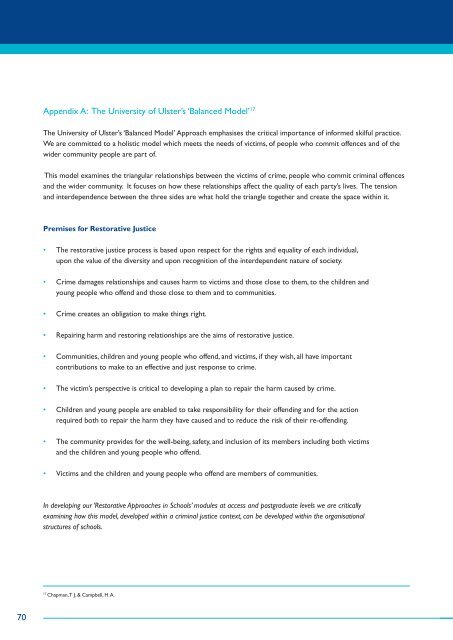Download the PDF document titled 'A Formative Evaluation - Dlvec.ie
Download the PDF document titled 'A Formative Evaluation - Dlvec.ie
Download the PDF document titled 'A Formative Evaluation - Dlvec.ie
You also want an ePaper? Increase the reach of your titles
YUMPU automatically turns print PDFs into web optimized ePapers that Google loves.
70<br />
Appendix A: The University of Ulster’s ‘Balanced Model’ 17<br />
The University of Ulster’s ‘Balanced Model’ Approach emphasises <strong>the</strong> critical importance of informed skilful practice.<br />
We are committed to a holistic model which meets <strong>the</strong> needs of victims, of people who commit offences and of <strong>the</strong><br />
wider community people are part of.<br />
This model examines <strong>the</strong> triangular relationships between <strong>the</strong> victims of crime, people who commit criminal offences<br />
and <strong>the</strong> wider community. It focuses on how <strong>the</strong>se relationships affect <strong>the</strong> quality of each party’s lives. The tension<br />
and interdependence between <strong>the</strong> three sides are what hold <strong>the</strong> triangle toge<strong>the</strong>r and create <strong>the</strong> space within it.<br />
Premises for Restorative Justice<br />
• The restorative justice process is based upon respect for <strong>the</strong> rights and equality of each individual,<br />
upon <strong>the</strong> value of <strong>the</strong> diversity and upon recognition of <strong>the</strong> interdependent nature of soc<strong>ie</strong>ty.<br />
• Crime damages relationships and causes harm to victims and those close to <strong>the</strong>m, to <strong>the</strong> children and<br />
young people who offend and those close to <strong>the</strong>m and to communit<strong>ie</strong>s.<br />
• Crime creates an obligation to make things right.<br />
• Repairing harm and restoring relationships are <strong>the</strong> aims of restorative justice.<br />
• Communit<strong>ie</strong>s, children and young people who offend, and victims, if <strong>the</strong>y wish, all have important<br />
contributions to make to an effective and just response to crime.<br />
• The victim’s perspective is critical to developing a plan to repair <strong>the</strong> harm caused by crime.<br />
• Children and young people are enabled to take responsibility for <strong>the</strong>ir offending and for <strong>the</strong> action<br />
required both to repair <strong>the</strong> harm <strong>the</strong>y have caused and to reduce <strong>the</strong> risk of <strong>the</strong>ir re-offending.<br />
• The community provides for <strong>the</strong> well-being, safety, and inclusion of its members including both victims<br />
and <strong>the</strong> children and young people who offend.<br />
• Victims and <strong>the</strong> children and young people who offend are members of communit<strong>ie</strong>s.<br />
In developing our ‘Restorative Approaches in Schools’ modules at access and postgraduate levels we are critically<br />
examining how this model, developed within a criminal justice context, can be developed within <strong>the</strong> organisational<br />
structures of schools.<br />
17 Chapman, T J. & Campbell, H. A.


